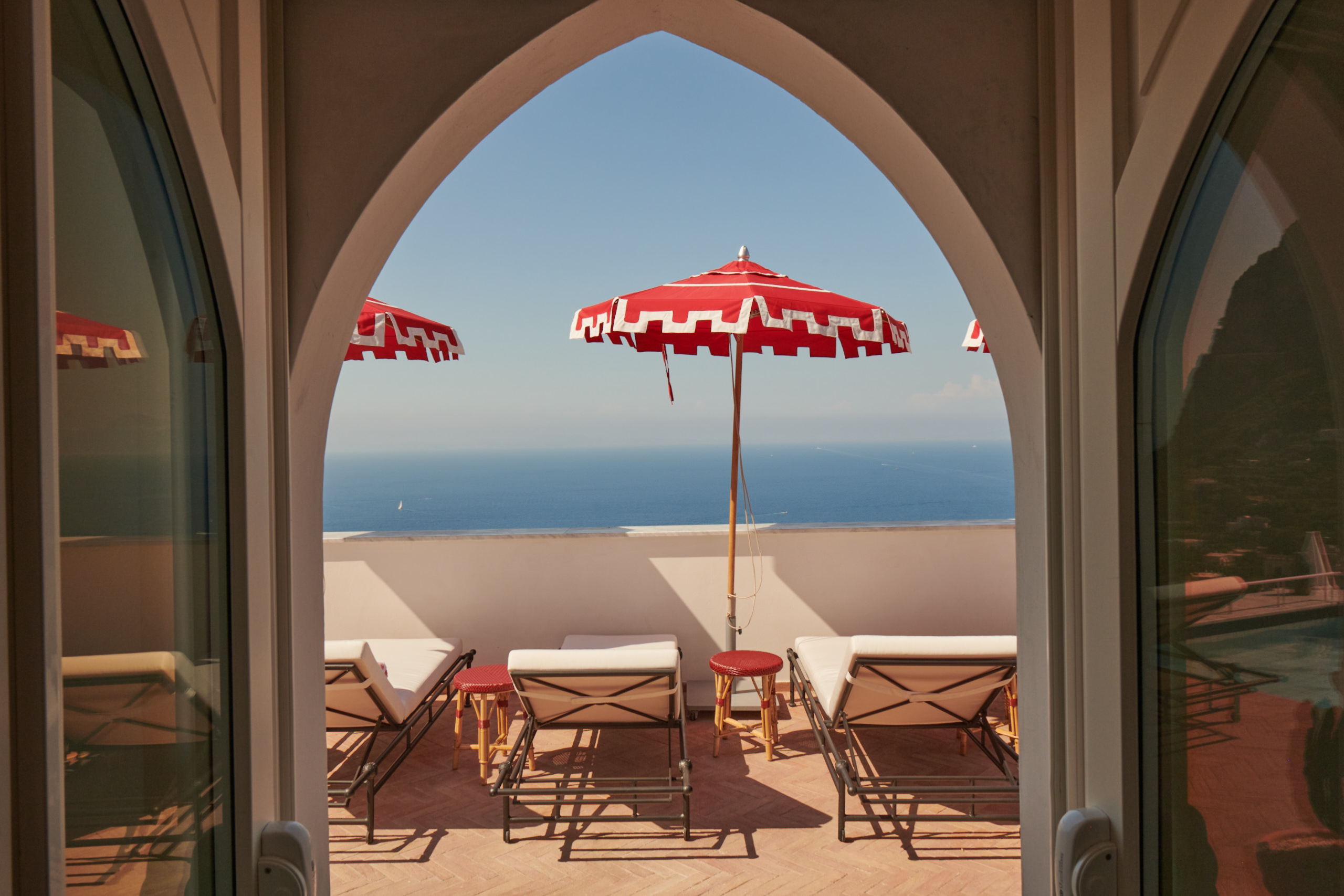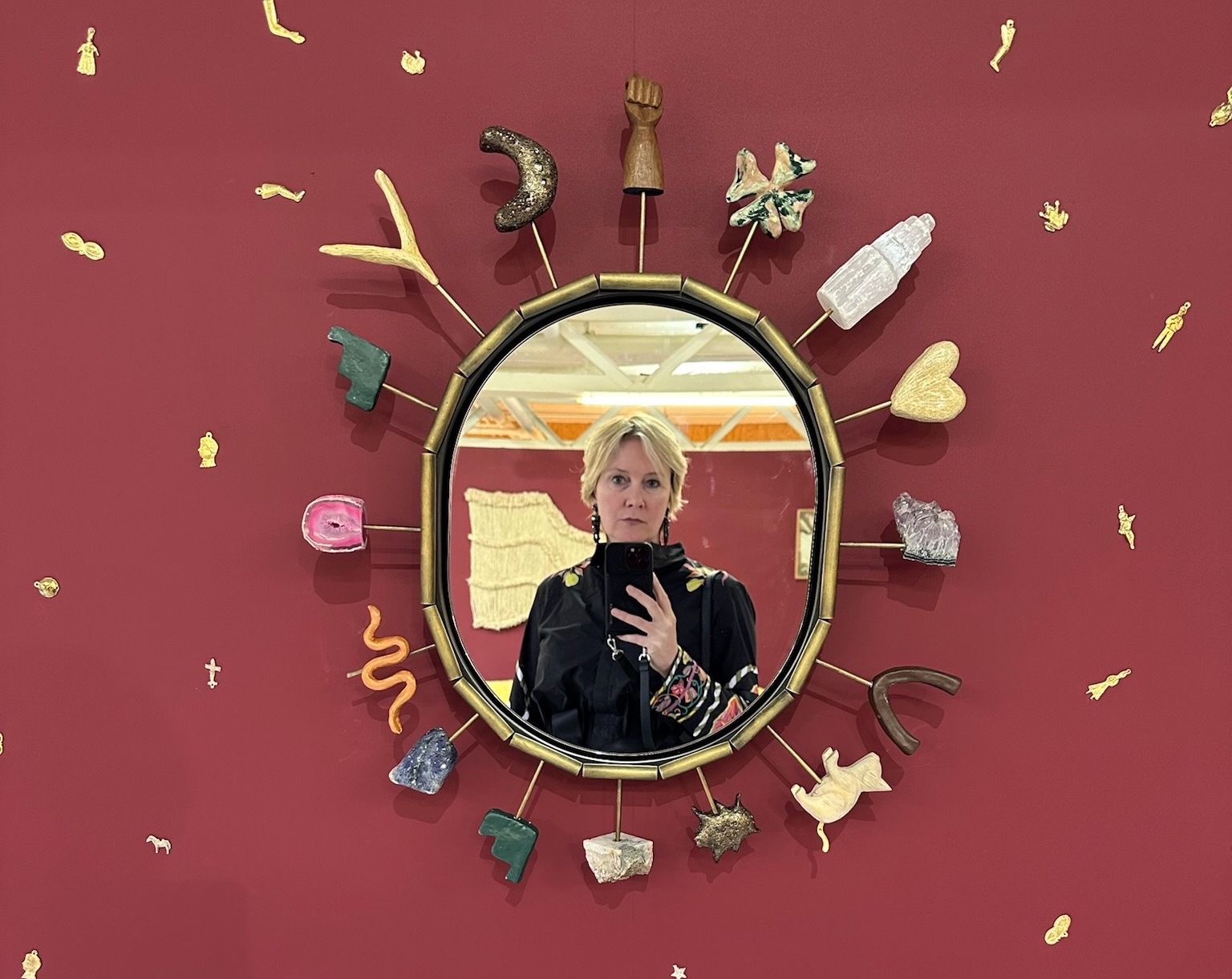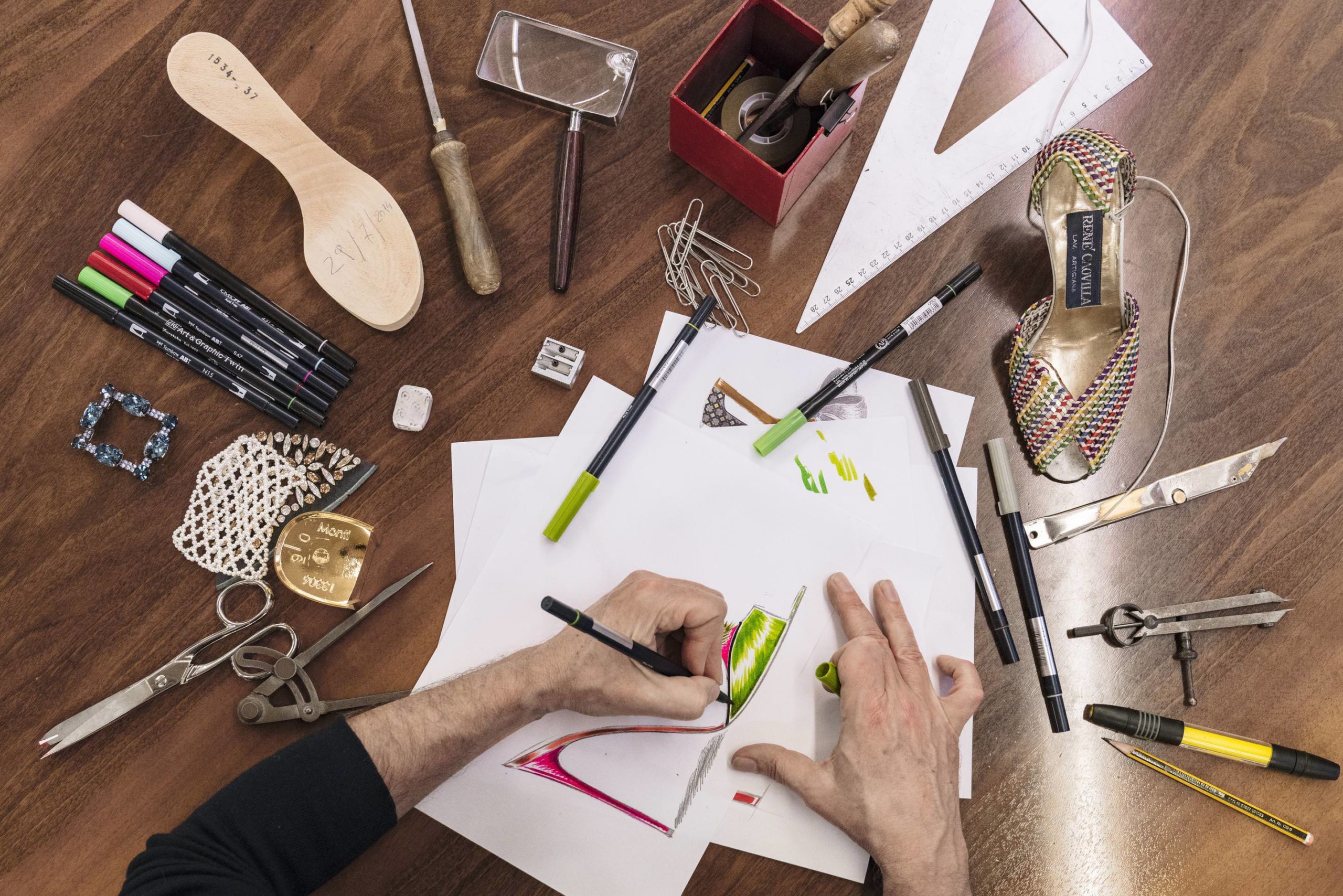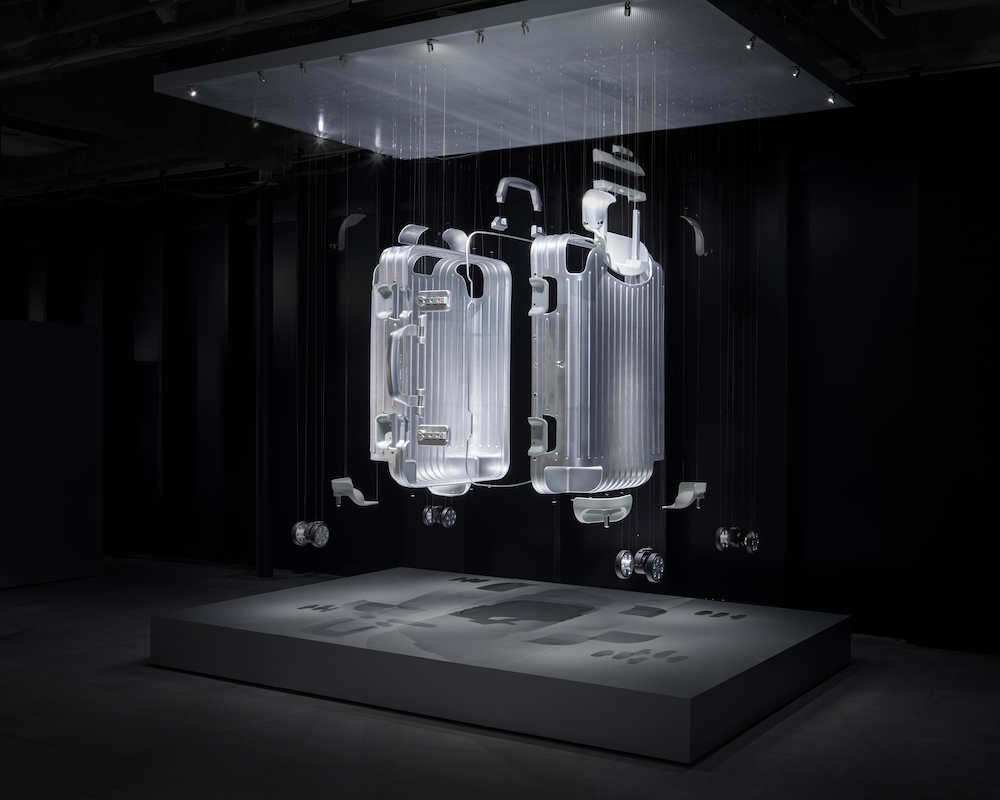Graziella Buontempo and Arnaud Lacombe share details on the art, design, and sustainability found at the palazzo.
In July 2022, il Capri Hotel opened on the idyllic coast of the Italian island of Capri. Imagined by the seasoned hospitality husband-and-wife duo Graziella Buontempo and Arnaud Lacombe, the whimsical property is housed within a 19th-century Neo-Gothic palazzo that combines Venetian style with a contemporary approach. Just steps away from the Piazzetta town square, overlooking the Gulf of Naples, the space is the couple’s first venture together, yet they are industry veterans on their own. Naples native Buontempo is the founder of the award-winning Parisian pizzeria Da Graziella, and Lacombe is the founder of the famed Parisian hospitality group Savoir Vivre, which includes Déviant, Vivant, Le Collier de la Reine, among other properties.
Formerly a private villa turned hotel in 1899, il Capri Hotel was re-designed by Buontempo and Lacombe to keep elements of the original architecture intact and refreshed, starting with its signature pink and white facade, which has been refreshed. To honor the property’s history and geographical positioning further, the hotel’s color palette was inspired by the pink pastel hues found across the islands of Capri, including the volcanic reds of the looming Mount Vesuvius.
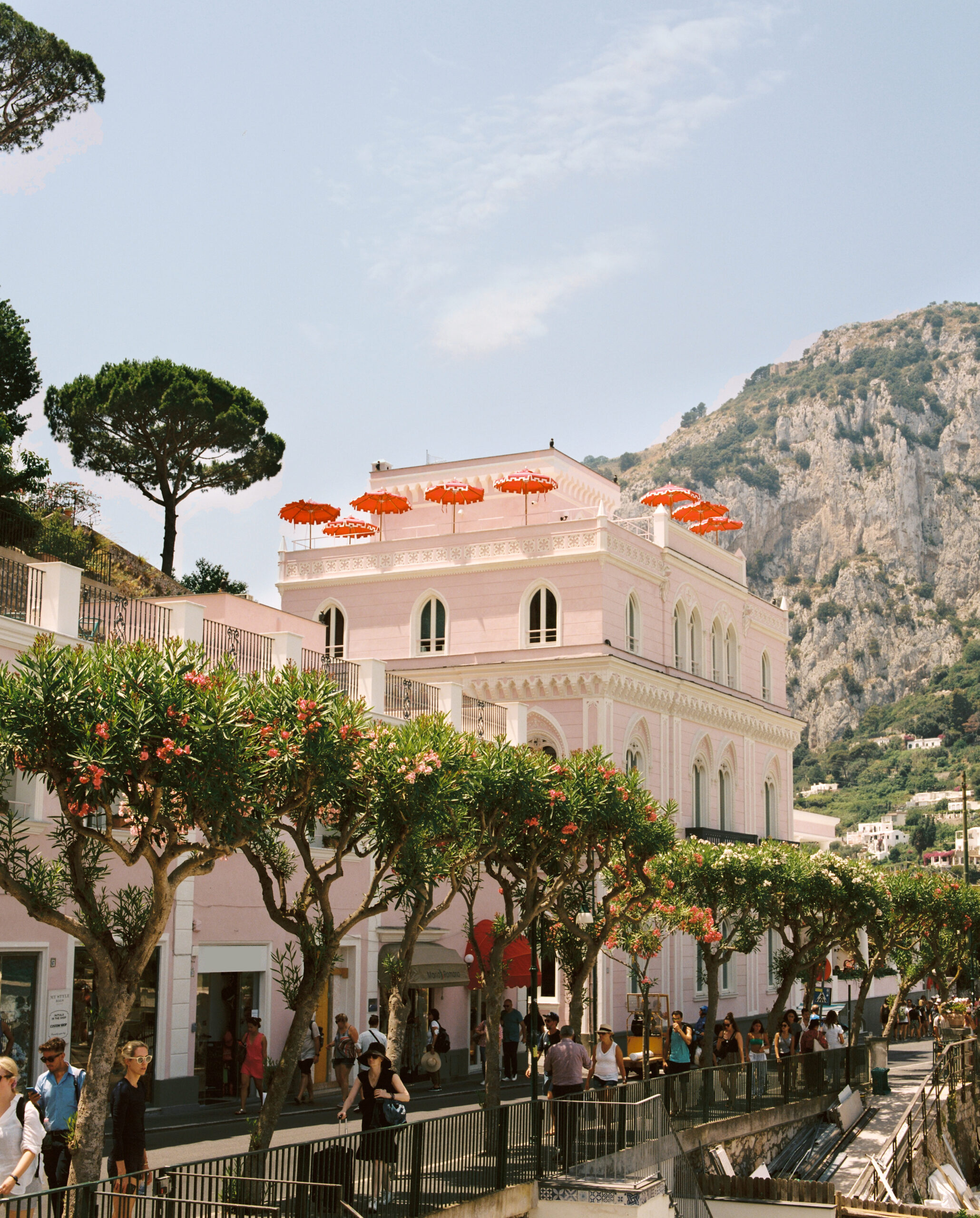
Courtesy of il Capri Hotel.
Past the dreamy exterior, guests inside will be greed to 21 rooms that pay homage to the island’s culture, infused with decor that evokes comfort and understated elegance. Sisal flooring complements natural materials and fibers like bamboo, wicker, wood, linen, and wool—all joining to highlight the island’s connection to nature. Additionally, craftsmen-created furniture and design pieces join a collection of curated antiques, as well as artworks from Buontempo’s personal collection, including family photos and newspaper clippings that explore her heritage, showing her aunt (and namesake), who was a cultural influence in Capri.
Throughout the hotel, culinary venues offer exemplary drinks, dining, and entertainment for those wishing to dine, drink, or dance into the night. The day-to-night restaurant, Vesuvio, features an outdoor terrace and views of the Tyrrhenian Sea; the lobby’s street-level cocktail bar, Caprirama Bar, also includes an extensive rooftop area; and the subterranean nightclub, Rumore, which also transforms into a movie theater and events space in the winter season.
Also on-site is a rooftop pool immersed in a lush terrace of local Mediterranean flora; a bespoke retail experience in the reception, featuring local and antique treasures; and a 24-hour snack bar filled with natural wine and local, made-in-house items.
Curious about the kismet found at il Capril Hotel, Whitewall spoke with its co-founders to learn how their story led them here, and why the hotel considers timeless design, esteemed amenities, and even social responsibility for an unforgettable stay.
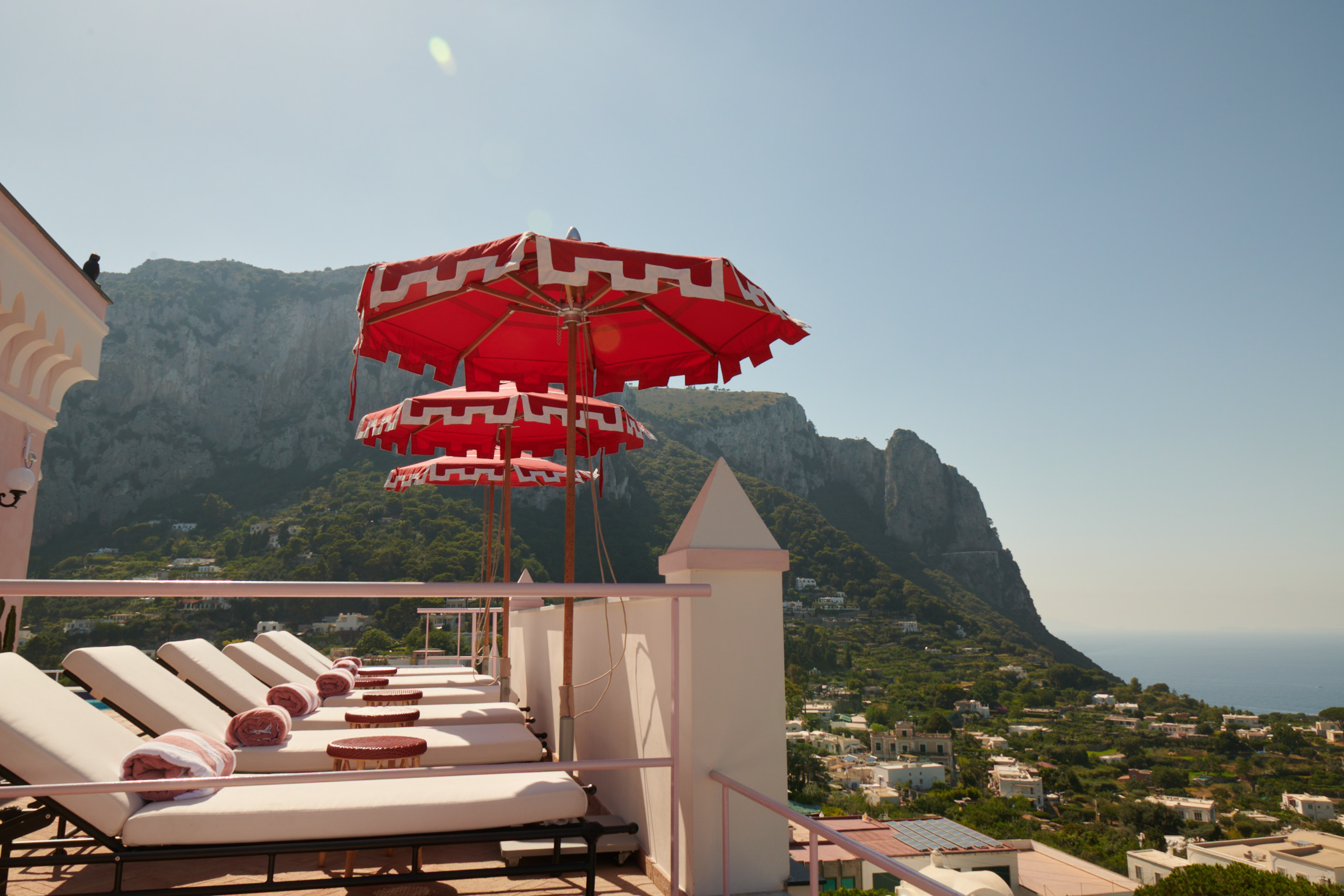
Courtesy of il Capri Hotel.
WHITEWALL: il Capri is a 19th-century building—a former private villa turned hotel in 1899. How did you work to create a space that balances original architectural details with contemporary design elements?
GRAZIELLA BUONTEMPO: From the very beginning, we wanted this space to feel like home and to be an ode to a timelessly elegant notion of design. When you come in, we wanted the vibe to be that of the Italian family vacation home, where you spend endless Summers playing with your cousins and creating adventures, where breakfast, lunch, and dinner get lost in time. Most of the design inspiration came from childhood places and memories. And then there’s Capri—an island like no other, a place of contrast. Jagged cliffs, lush greenery, submarine grottoes, and infinite palettes of blue and green water. The island takes you by the guts and devours you with its nature and beauty. That’s why we wanted to keep things simple and natural with sisal flooring, lots of rattan and bamboo, soft linen curtains, but also wool sofas.
99 percent of the rooms enjoy an astounding sea view. We didn’t feel the need to make the rooms too loud and overflowing with decorative elements. The palazzo had always been pink, even though it was rather withered when we started working on it. When I close my eyes and think of Capri, pink comes to mind. We chose a more pastel-toned one as an homage to the different nuances you can find on the island—from the soft or deeper hues of bougainvilleas to the infinite, dazzling mixes that take your breath away at sunrise and sunset. There is not a single shade of pink that tinges the sky like the day before.
“When I close my eyes and think of Capri, pink comes to mind.” —Graziella Buontempo
WW: Did you work with local artisans to design specific spaces or furniture pieces?
GB: We worked with various artisans, both local and across Europe for specific details, like: English artisans and brands for some lampshades and lamp bases (Alfred Newall, Melodi Horne); an Italian family-run business for all the tapestries; and all the furniture is vintage, sourced from various dealers across Italy and Europe.
WW: Artwork featured in the hotel was sourced from your personal collection. Can you tell us about those pieces, and why you chose to share them publicly?
GB: We decided to add an even more personal touch to every room by displaying some of the stunning posters that various mid-century artists (like Mario Schifano, Michelangelo Pistoletto, Renato Guttuso, and Marilú Eustachio) created for the Premio Malaparte, a literary prize that my aunt and namesake founded with Alberto Moravia and that brought to the island some of the most influential writers of our modern times—including Saul Bellow, Nadine Gordimer, Susan Sontag, and Isabel Allende, among others.
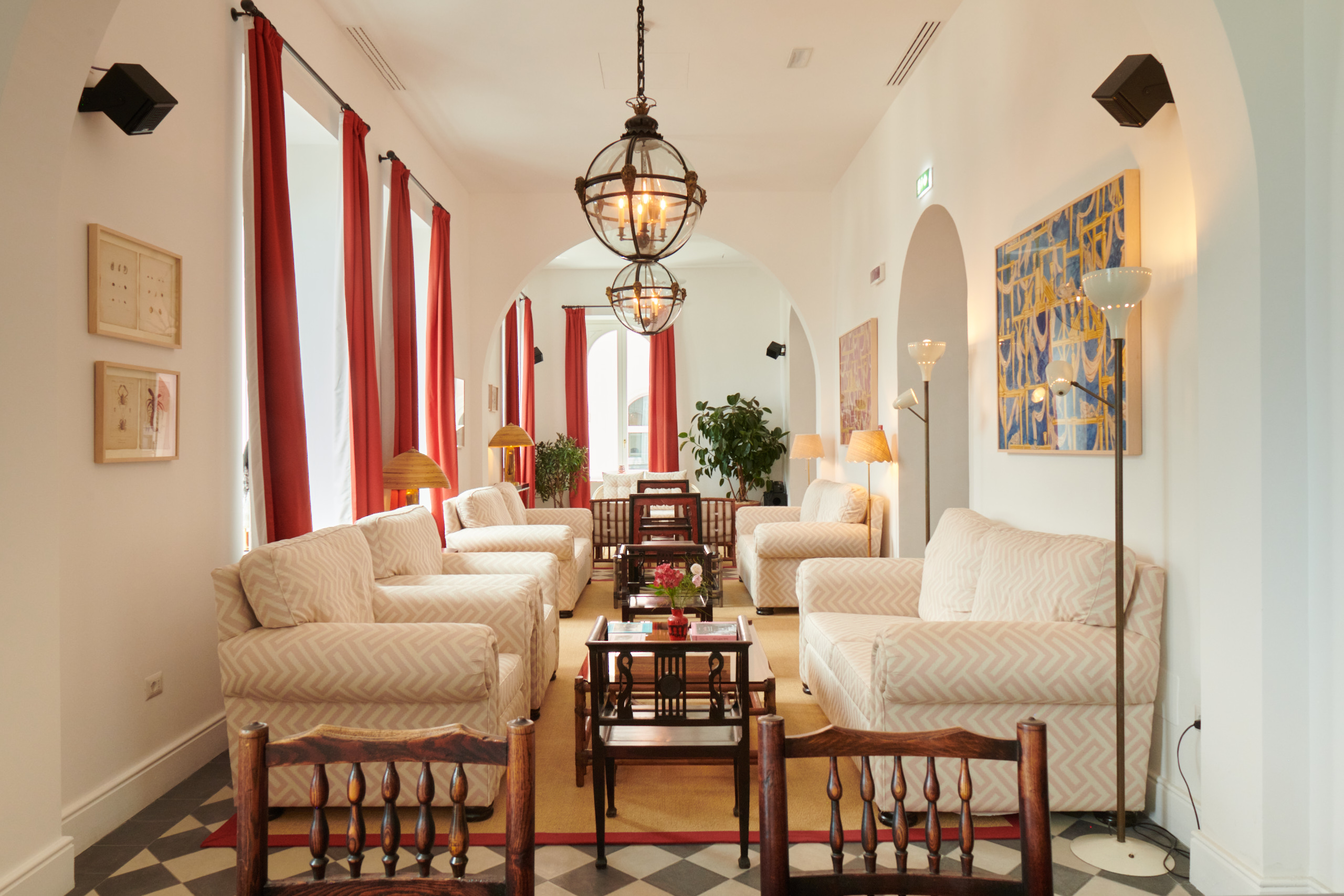
Courtesy of il Capri Hotel.
WW: What is your art collection like, outside of the pieces featured in the hotel?
ARNAUD LACOMBE: Mostly pieces by friends and young artists whose work always speaks to us and moves us in a visceral, meaningful way. A stunning tapestry by our friend Desiree Moheb Zandi is in our daughter’s nursery. We bought it when we were still in Paris and the colors and imagery reminded me immediately of the arrangement of sceneries and nuances from my parents’ home in Naples. Our daughter now loves it and tries to grasp the cascading threads.
Another great piece by our friend Jules Rivemale is in our living room—a monumental work made of charcoal representing the Corsican cliffs where Jules’s summer family house is. Likewise, it reminded us of the rocky beaches of Naples and Capri.
WW: Congratulations on your recent addition to the family. How does being partners in life and work, as well as parents, impact your approach to hospitality?
AL: It has been a whirlwind summer as our daughter arrived ten days before the hotel’s opening. We knew from the beginning that timing wasn’t the best, but that’s where being two in life and work comes in handy. Our eye and attention to detail have changed, as we now notice things and situations we wouldn’t have necessarily noticed before without a newborn. However, the hotel remains a strictly adult-only property. Capri is beautiful but, unless used to it, you won’t get sandy beaches and comfortable walks. It’s all rocks and steep, uphill walks.
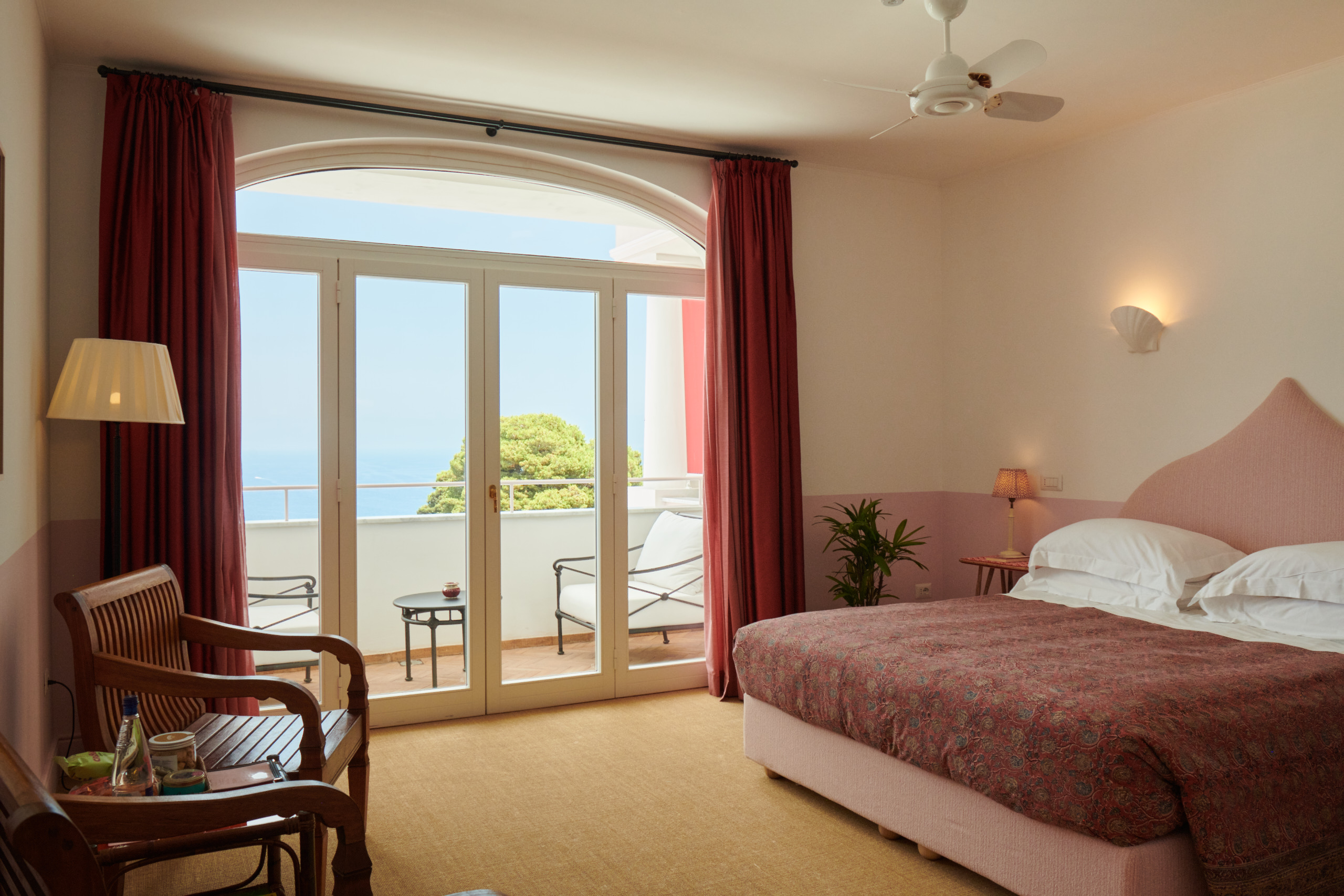
Courtesy of il Capri Hotel.
WW: The hotel has a large focus on food and beverage, notably due to your relationship with the industry as the founder of Da Graziella. What do the culinary venues—including Vesuvio, Caprirama Bar, and Rumore—offer guests that is particularly unique?
AL: Whether it’s for Savoir Vivre or Da Graziella, which is also part of Savoir Vivre, when it comes to food and beverage, our approach is always the same—simple and straightforward. The same thing goes for the various outlets at the hotel. It’s local, it’s in season, it’s uncomplicated, and always has a distinctive twist. You get your average Spaghetto alla Nerano for example, but we like to twist it with some local dried fish ro. Our super successful Club Sandwich has mayo, but we make it a carbonara one.
Our wine selection focuses, as we always have, on clean, natural wines—a huge leap from most wine menus on the island, where in some cases, grape varieties are written down with no mention whatsoever of the winemaker, wine name, or year of production. If I’m paying 25 Euros for a glass of white wine, as is the case in some renowned island restaurants, I don’t want it to be randomly labeled as simply “white wine glass” or “Falanghina.” I want to know what and whose work am I drinking.
“Our approach is always the same—simple and straightforward.” —Arnaud Lacombe
WW: The hotel also hosts a boutique, featuring a selection of clothing, beauty products, locally published books, and records. How do you approach curating these items?
GB: The idea with the reception boutique was to feature items by creators and brands that share our own values of kindness and respect for individuals, cultures, and the planet. There are books from the only publishing house and bookstore in Capri, La Conchiglia, whose pastel-toned books I have been collecting forever. There are records by friends and local powerhouse musicians from Periodica Records, like Manny Whodamanny and Mystic Jungle. There are also extra colorful handmade headbands and fans by Colombian friend Lucia Echevarria of Magnetic Midnight, small note-taking copybooks handmade by an old lady in the center of Naples, and of course, our Nomasei collaboration sandals!
For beauty products, which are also featured in the hotel rooms’ SPA Minibar, there is definitely a lot of research and personal trying before making a choice. I read somewhere that Italians and French have a more “pharmaceutical” approach to beauty products as most of the shopping is done at the pharmacy. This has quite an impact on the packaging of products, which is generally less catchy and more polished. So, when it came down to choosing the products, besides the natural need for them to be free of all pesky ingredients, the appeal of the product aesthetic per se was also very important.
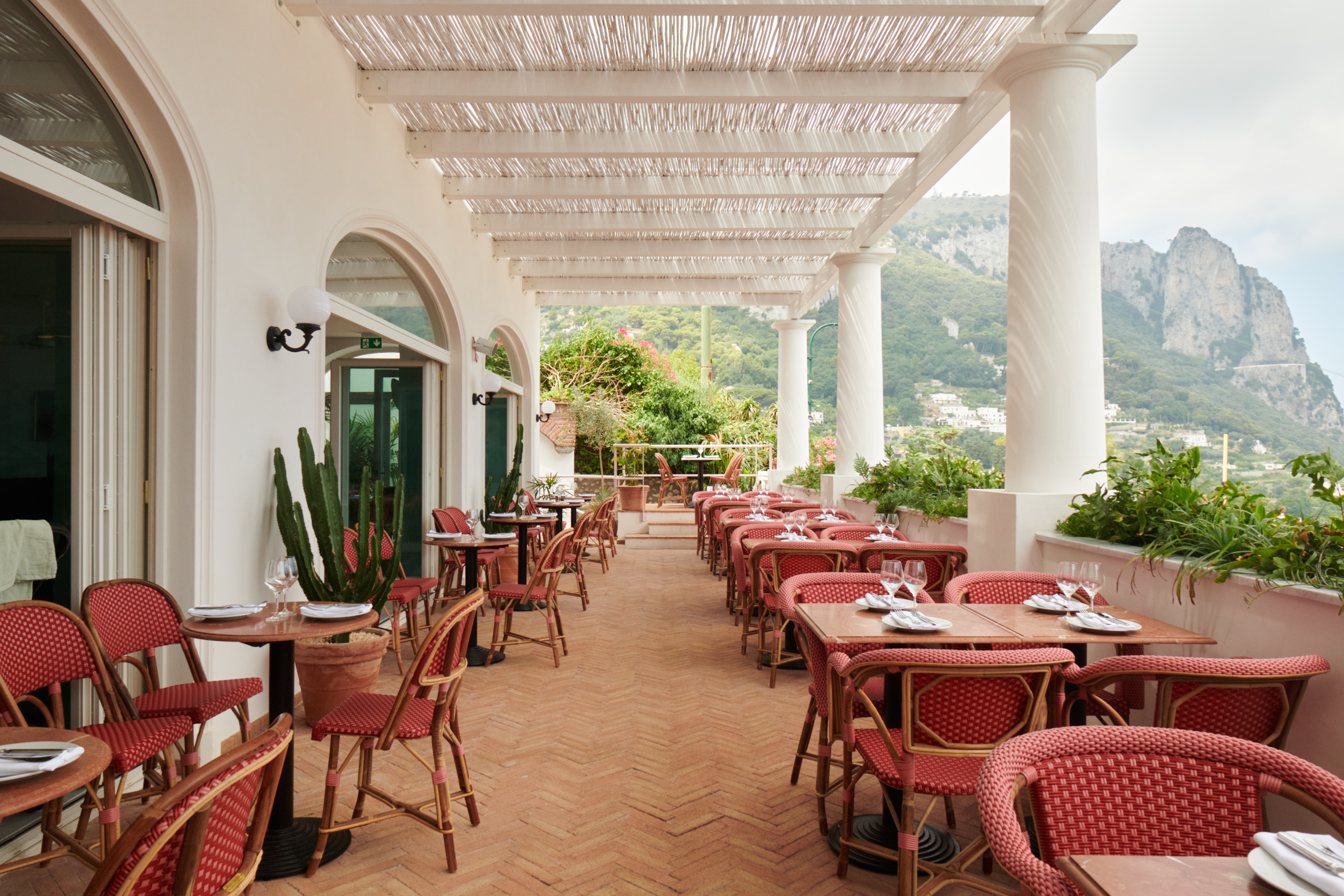
Courtesy of il Capri Hotel.
WW: As you briefly mentioned, the hotel collaborated with the emerging French brand Nomasei for a line of custom Hotel de la Plage sandals, which were hand-crafted in Montopoli in Val d’Arno, Italy. Can you tell us about why this made sense for a collaboration?
AL: We had been following Marine and Paule’s work for some time and have always been attracted to the classic elegance of their shoes. It was a self-evident choice given their very sustainable approach which is in line with our Hotel’s philosophy. The icing on the cake was that the sandals we chose are called Hotel de la Plage, so it couldn’t have been more appropriate. We had several conversations and opted for two colors that are representative of either the Hotel (the pink ones) or island colors (a duck blue) and, for the first time ever, produced men’s shoe sizes.
WW: How does the hotel consider the topic of sustainability—with facets like food, design, water, electricity, or circular economy at large?
AL: It is a very important subject to us and we strive to do our best to ensure our footprint is as low as possible. We buy local and exclusively in-season when it comes to food. We do everything in-house to assure freshness and avoid needless transportation. All our bread and pasta are homemade daily, and the same thing goes for all breakfast pastries. We reuse food before it goes to waste. For example, if a fish isn’t sold, we prepare it and use it as filling for ravioli, and put it as a special of the day.
We eliminated minibars and their plastic packaging and offered a megabar fridge at the reception filled with homemade sundries, eliminating plastic in rooms by avoiding wasteful mini toiletries and replacing them with refillable items in customized glass bottles. We created a ban on straws of all kinds. We’re also trying to implement solar panels on part of our rooftop to be as independent as possible when it comes to energy. These are little gestures that go a long way in what is one of the most wasteful industries.
“We strive to do our best to ensure our footprint is as low as possible.” —Arnaud Lacombe
WW: We are moving past the days of the global COVID-19 pandemic. Looking back, how did that time impact your view of the importance of the food and beverage, and hospitality worlds?
AL: The isolation we all experienced during the pandemic has beyond doubt impacted us in meaningful ways. When it comes to hospitality, it has reinforced people’s need to mingle and to take a slower approach to life. That’s why all our Hotel’s common spaces are thought out as a meeting point: whether you’re a guest or not, you can come in, have a drink, eat something and meet new people, which is not necessarily what most people do in hotels in Capri. We managed to create a space that is very intimate and personal, where you just want to linger with your partner, meet up with friends for food and drinks, curl up on a sofa or under the sun and read a book, or kick back with a cocktail and backgammon.



